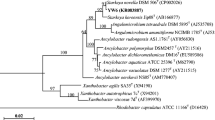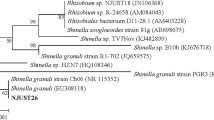Abstract
Ancylobacter sp. XJ-412-1, capable of degrading metsulfuron-methyl, was isolated from sulfonylurea-contaminated soil. When metsulfuron-methyl was provided as the sole carbon source, more than 90.5% of metsulfuron-methyl at concentration of 50 mg l−1 was degraded by strain XJ-412-1 after incubation at 30°C for 7 days. The initial degradation products of metsulfuron-methyl (MSM), thifensulfuron-methyl (TSM), and bensulfuron-methyl (BSM) by XJ-412-1 were identified as corresponding deesterified derivatives by liquid chromatography-mass spectrometry, which indicated a primary pathway of the deesterification of these three sulfonylurea herbicides. The carboxyesterase activity of the cell-free extracts was assayed and strongly inhibited by 4-chloromercuribenzoic acid (PCMB), diethyl pyrocarbonate (DEPC), phenylmethylsulfonyl fluoride (PMSF), and malathion.



Similar content being viewed by others
References
Beyer EM, Duffy MJ, Hay JV, Schlueter DD (1988) Sulfonylureas. In: Kearney PC, Kaufman DD (eds) Herbicide chemistry degradation and mode of action. Dekker, New York, pp 118–183
Blair AM, Martin TD (1988) A review of the activity, fate and mode of action of sulfonylurea herbicides. Pestic Sci 22:195–218
Boschin G, D’Agostina A, Arnoldi A, Marotta E, Zanardini E, Negri M, Valle A, Sorlini C (2003) Biodegradation of chlorsulfuron and metsulfuron-methyl by Aspergillus niger in laboratory conditions. J Environ Sci Health B 38:737–746
Bradford MM (1976) A rapid and sensitive method for the quantitation ofmicrogramquantities of protein utilizing the principle of protein-dye binding. Anal Biochem 72:248–254
Brown HM (1990) Mode of action, crop selectivity, and soil relations of the sulfonylurea herbicides. Pestic Sci 29:263–281
Brown HM, Joshi MM, Van AT, Carski TH, Dulka JJ (1997) Degradation of thifensulfuron-methyl in soil: role of microbial carboxyesterase activity. J Agric Food Chem 45:955–961
Brusa T, Ferrari F, Bolzacchini E, Rindone B (2001) Study on the microbiological degradation of bensulfuron-methyl. Ann Microbiol 51:189–199
Chatterjee S, Dutta TK (2003) Metabolism of butyl benzyl phthalate by Gordonia sp. strain MTCC4818. Biochem Biophys Res Commun 309:36–43
Doronina NV, Trotsenko YA, Tourova TP, Kuznetsov BB, Leisinger T (2001) Albibacter methylovorans gen. nov., sp. nov., anovelaerobic, facultatively autotrophic andmethylotrophic bacterium that utilizes dichloromethane. Int J Syst Bacteriol 51:1051–1058
Firsova JE, Doronina NV, Trotsenko YA (2010) Analysis of the key functional genes in new aerobic degraders of dichloromethane. Microbiology 79:72–78
Flaburiari A, Kristen U (1996) The influence of chlorsulfuron and metsulfuron methyl on root growth and on the ultrastructure of root tips of germinating maize seeds. Plant Soil 180:19–28
Guo P, Wang BZ, Hang BJ, Li L, Ali SW, He J, Li SP (2009) Pyrethroid-degrading Sphingobium sp. JZ-2 and the purification and characterization of a novel pyrethroid hydrolase. Int Biodeterior Biodegrad 63:1107–1112
Holt JG, Krieg NR, Sneath PHA, Staley JT, Williams ST (1994) Bergry’s manual of derterminative bacteriology, 9th edn. Williams & Wilkins, Baltimore, pp 626–640
Ismail BS, Lee HJ (1995) Persistence of metsulfuron-methyl in two soils. J Environ Sci Health B 30:485–497
Khalameyzer V, Fischer I, Bornscheuer UT, Altenbuchner J (1999) Screening, nucleotide sequence and biochemical characterization of an esterase from Pseudomonas fluorescens with high activity towards lactones. Appl Environ Microbiol 65:477–482
Lane DJ (1991) 16S/23S rRNA sequencing. In: Stackebrandt E, Goodfellow M (eds) Nucleic acid techniques in bacterial systematics. Wiley, Chichester, pp 371–375
Li Y, Zimmerman WT, Gorman MK, Raiser RW, Fogiel AJ, Haney PE (1999) Aerobic soil metabolism of metsulfuron-methyl. Pestic Sci 55:434–445
Ma JP, Wang Z, Lu P, Wang HJ, Ali SW, Li SP, Huang X (2009) Biodegradation of the sulfonylurea herbicide chlorimuron-ethyl by the strain Pseudomonas sp. LW3. FEMS Microbiol Lett 296:203–209
Molinari F, Brenna O, Valenti M, Aragozzini F (1996) Isolation of a novel carboxylesterase from Bacillus coagulans with high enantioselectivity toward racemic esters of 1, 2-O-isopropylideneglycerol. Enzyme Microb Technol 19:551–556
Nicholls PH, Evans AA (1998) The behaviour of chlorsulfuron and metsulfuron in soils in relation to incidents of injury to sugar beet. In: Proceedings 1998 British Crop Protection Conference Weeds, Brighton, pp 549–556
Ørskov J (1928) Beschreibung eines neuen Mikroben, Microcyclus aquaticus, mit eigentu¨mlicher Morphologie. Zentralbl. Bakteriol. Parasitenkd. Infektionskr Hyg Abt 1 Orig 107:180–184
Raj HD (1983) Proposal of Ancylobacter gen. nov. as a substitute for the bacterial genus Microcyclus Ørskov 1928. Int J Syst Bacteriol 33:397–398
Raj HD (1989) Oligotrophic methylotrophs: Ancylobacter(basonym ‘‘Microcyclus’’ Ørskov) Raj gen. nov. Crit Rev Microbiol 17:89–106
Xu J, Li XS, Xu YJ, Qiu LH, Pan CP (2008) Biodegradation of pyrazosulfuron-ethyl by three strains of bacteria isolated contaminated soils. Chemosphere 74:682–687
Yu YL, Wang X, Luo YM, Yang JF, Yu JQ, Fan DF (2005) Fungal degradation of metsulfuron-methyl in pure cultures and soil. Chemosphere 60:460–466
Zanardini E, Arnoldi A, Boschin G, D’Agostina A, Negri M, Sorlini C (2002) Degradation pathways of chlorsulfuron and metsulfuron-methyl by a pseudomonas fluorescens strain. Ann Microbiol 52:25–37
Acknowledgments
This work was supported by grants from the National Natural Science Foundation of China (30900044, 30830001), Fund for the Doctoral Program of Higher Education (20090097120031), Fund for SATAS (2010hzsZDZXZ001).
Author information
Authors and Affiliations
Corresponding author
Rights and permissions
About this article
Cite this article
Lu, P., Jin, L., Liang, B. et al. Study of Biochemical Pathway and Enzyme Involved in Metsulfuron-Methyl Degradation by Ancylobacter sp. XJ-412-1 Isolated from Soil. Curr Microbiol 62, 1718–1725 (2011). https://doi.org/10.1007/s00284-011-9919-z
Received:
Accepted:
Published:
Issue Date:
DOI: https://doi.org/10.1007/s00284-011-9919-z




